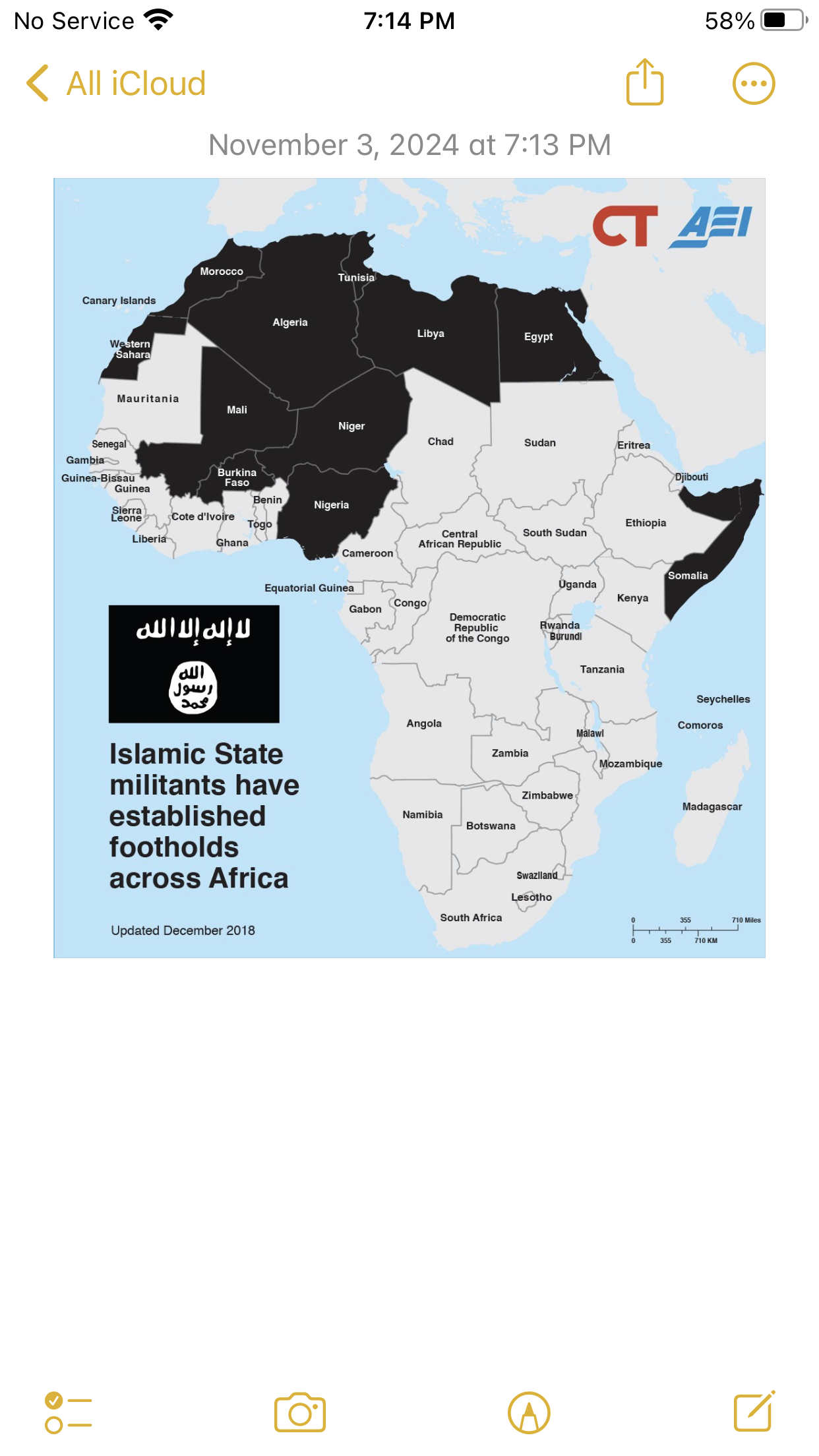𝙊𝙘𝙩𝙤𝙗𝙚𝙧 𝙢𝙤𝙣𝙩𝙝𝙡𝙮 𝙗𝙪𝙡𝙡𝙚𝙩𝙞𝙣 :𝐓𝐡𝐞 𝐞𝐩𝐢𝐜𝐞𝐧𝐭𝐞𝐫 𝐨𝐟 𝐈𝐬𝐥𝐚𝐦𝐢𝐜 𝐒𝐭𝐚𝐭𝐞 𝐚𝐜𝐭𝐢𝐯𝐢𝐭𝐲 𝐢𝐬 𝐧𝐨𝐰 𝐍𝐨𝐫𝐭𝐡 𝐀𝐟𝐫𝐢𝐜𝐚.
 𝐀𝐛𝐬𝐭𝐫𝐚𝐜:
𝐀𝐛𝐬𝐭𝐫𝐚𝐜:
The analysis of Islamic State (IS) attacks in October 2024 shows a decrease in operations in Iraq due to increased security pressures and counter-terrorism measures. In Syria, IS carried out 28 attacks, mainly targeting the Syrian Democratic Forces. West Africa had the highest IS activity, with 37 attacks resulting in 75 fatalities. The data suggests a shift in IS’s focus to regions with weaker security infrastructures, allowing the group to expand its influence and recruit members.
Analysis of the “Islamic State” Spread Globally
in October 2024
Dr. Marwan Shehadeh
This analysis examines the scale of military operations and the casualty numbers resulting from attacks by the Islamic State (IS) in various countries. The data was sourced from statistical reports published in Al-Naba, the weekly IS newspaper, throughout October 2024. Occasionally, the analysis draws on data published over extended periods, especially when these reports reflect IS’s security and military activities across cities and provinces. It’s important to note that verifying the accuracy of IS’s military statements can be challenging, though the statistics on operations and casualties generally approximate reality. Nonetheless, the group often inflates its figures to amplify its influence, which is a common practice among militant organizations. These numbers can still serve as indicators of the group’s operational effectiveness and geographical spread.
At times, inaccuracies appear in the target descriptions, as seen in cases where IS claimed to have targeted personnel from the International Committee of the Red Cross, while the actual targets were from a different humanitarian organization. For this analysis, data was extracted from five issues of Al-Naba (issues 463 to 467), covering the group’s activities in October.
The following tables and charts provide a breakdown of attack numbers, casualties, and the geographical distribution of IS’s military activities.
Overview of Attacks and Casualties by Region
|
Date |
Target |
Attacks numbers |
Killing & Injuries numbers |
Areas States/ cities |
|
|
|
3 |
10 |
Province of Iraq |
|
|
|
|
|
Salah aldeen |
|
|
|
|
|
AlAnbar |
|
|
|
1 |
|
North Baghdad |
|
|
|
1 |
|
Dijleh |
|
|
|
1 |
|
kirkouk |
|
|
|
|
|
Deyala |
|
|
|
|
|
Alfalouja |
|
|
|
28 |
24 |
Province of the Levant / Cham |
|
|
|
17 |
|
Alkhair |
|
|
|
1 |
|
Halab |
|
|
|
9 |
|
Albaraka (Dair al zour) |
|
|
|
1 |
|
Riqqa |
|
|
|
|
|
Homs |
|
|
|
|
|
Hama |
|
|
|
37 |
75 |
Province of West Africa |
|
|
|
|
|
|
|
|
|
|
|
|
|
|
|
18 |
51 |
Central African province |
|
|
|
|
|
Congo |
|
|
|
|
|
|
|
|
|
13 |
27 |
Province of Mozambique |
|
|
|
|
|
Rawanda |
|
|
|
|
|
|
|
|
|
|
|
Province of Sahel |
|
|
|
|
|
Mali |
|
|
|
|
|
Chad |
|
|
|
|
|
Niger |
|
|
|
|
|
|
|
|
|
4 |
13 |
Province of Khurasan |
|
|
|
|
|
Karaman – Iran |
|
|
|
|
|
Afghanistan |
|
|
|
|
|
Pakistan |
|
|
|
|
|
Province of East Asia |
|
|
|
|
|
Oman |
|
|
|
|
|
Somalia |
|
|
|
|
|
Turkey |
|
|
|
|
|
Russia |
|
|
|
|
|
Germany |
|
|
|
|
|
Azerbaijan |
|
|
|
|
|
Total |
Analytical Overview of Attacks and Casualties in Key Regions
1.Iraq: IS operations in Iraq have decreased compared to previous years, reflecting increased security pressures and counter-terrorism measures. Only three attacks were reported, resulting in 10 fatalities, with attacks distributed across cities such as Dijleh, Kirkuk, and North Baghdad.
2.Syria: In Syria, IS carried out 28 attacks with a total of 24 casualties. Most attacks were concentrated in Al-Khair, where 17 incidents targeted Syrian Democratic Forces (SDF), followed by 9 attacks in Deir ez-Zor (Al Baraka). Additional single incidents were reported in Aleppo and Raqqa.
4.Central and East Africa: The Central African Province ranks second in activity, with 18 attacks and 51 casualties reported, mostly in Congo. Meanwhile, in Mozambique, IS conducted 13 attacks that resulted in 27 fatalities.
5.Khurasan Province: In Khurasan, 4 attacks resulted in 13 casualties, targeting military and security personnel across Afghanistan and Pakistan.
Casualties by Type and Target Group
|
Killing & injuries
|
||
|
Numbers
|
Type
|
|
|
165
|
Murtad, and Kafer
|
|
|
97
|
Crusaders
|
|
|
15
|
Rawafd & Nusairi (Shia’)
|
|
|
Destroyed and Torched
|
||
|
Numbers
|
Type
|
|
|
28
|
vicle
|
|
|
4
|
Different vicles
|
|
|
17
|
Four wheel vicles
|
|
|
2
|
Born base
|
|
|
34
|
Born houses
|
|
|
2
|
Armored
|
|
|
5
|
Captured/ Prisoners
|
|
The breakdown of casualties shows that IS continues to focus on sectarian and religious conflicts:
This data underscores IS’s targeting strategy, which includes attacks on non-Muslims in Africa and sectarian violence against Shia groups in Iraq and Syria.
Material Losses Caused by IS Attacks
In the course of its operations, IS also engaged in significant material sabotage, targeting infrastructure such as vehicles and buildings. Notably, they burned 34 houses and captured five individuals from the Congolese and Ugandan military during clashes in Eastern Congo.
Observations and Conclusion
The analysis of IS operations reveals that the group remains active across multiple regions, particularly in Africa, where it has increasingly focused its resources. West Africa and Central Africa emerged as the hotspots for IS attacks, surpassing regions like Iraq and Syria in both attack frequency and casualty numbers. The data suggests a shift in IS’s operational focus, with a clear emphasis on regions with weaker security infrastructures, allowing the group to expand its influence and recruit members.
The attached charts illustrate:
1.Destroyed and Torched Assets: A breakdown of IS’s impact on infrastructure, showing high numbers of destroyed vehicles and burned houses.
2.Casualty Distribution by Target Group: Visuals differentiating between sectarian and non-sectarian casualties.
3.Regional Attack Comparison: Charts comparing the number of attacks and casualties across key IS regions.
These visuals provide a clearer understanding of IS’s operational footprint and the scope of its activities worldwide.
This report, enhanced with visual data and comprehensive analysis, aims to provide a clearer picture of IS’s current activities and the geographical trends in their operations. The data, while often exaggerated by IS, still serves as a valuable indicator of the group’s presence and influence.


